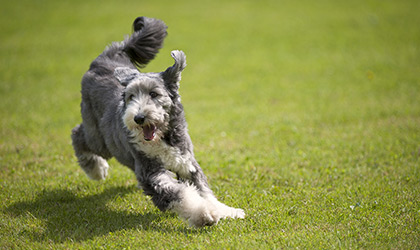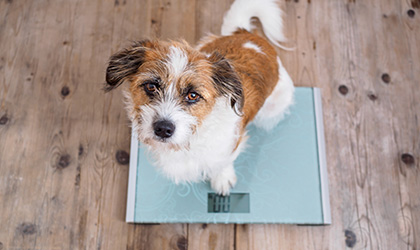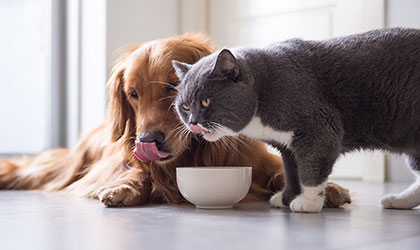
Though wellness activists and nutritionists may express conflicting opinions on the latest diet fad or food trend, there is something they resoundingly agree on: water is the secret to optimal health. This fact prevails in the animal kingdom too. Newsflash: your pet’s body is 80% water. Yep, that’s 20% more than ours. As you can imagine then, the proper hydration of your furry friend is a matter of great importance – you could even say it takes precedence over our own needs. Optimal fluid intake supports urinary tract health, regulates body temperature, maintains energy levels, and promotes healing and recovery. Think of it as a cornerstone of your pet’s overall wellbeing: neglect it, and your furry friend could run into all kinds of trouble, with numero uno being dehydration. Quench your thirst for knowledge with this guide on keeping your pets hydrated.
What are the signs of dehydration?
Common signs of dehydration include:
-
Excessive panting
-
Sunken, dry eyes
-
Dry, sticky gums
-
Loss of energy
-
Vomiting and/or diarrhoea
-
Loss of skin elasticity
You can perform a skin test to establish if your pet is dehydrated. Gently grab a fold of skin (typically between the shoulder blades or back of the neck). If the skin pings back into place, it signals your pet is sufficiently hydrated; however, if the skin returns to its place slowly, your furry friend may be dehydrated. If you suspect this is the case, consult your vet immediately. Dehydration is an emergency and requires serious attention.
How much does my pet need?
As a rule of thumb, your pet needs an ounce of water for each pound of body weight. For instance, a 65lb Irish Setter needs 65 ounces of water, while a 15lb Maine Coon cat only needs 15 ounces. Once you have a better understanding of your companion’s hydration requirements, you can begin tracking if they’re being met.
How can I keep my pet hydrated?
Ensure your pet always has access to fresh water
Your furry-friend should always have access to fresh, clean drinking water, full stop. If you’re leaving the house for the day, ensure your pet has plenty to drink. The same applies to spending time outside: always fill up their water bowl and bring it with you. It’s equally important to clean their bowl every day to prevent bacteria growing. Oh, and it goes without saying that you must change their water regularly. How would you like to quench your thirst with a stagnant beverage, featuring inconspicuous debris? Mmm, no thanks.
Provide more water bowls
Another simple way to up your pet’s water consumption is by increasing the number of water bowls in your home. Place bowls of fresh water in your companion’s favourite hangout spots: your bedroom, living room, and, of course, outside. Make sure the bowls are far from litter trays, sunlight and food bowls – a dignified cat or dog is guaranteed to think ‘yuck’ at those tuna flakes or kibble floating in their water bowl. Finally, if your house caters for both canines and felines, it’s best to separate their water bowls to avoid any territorial tiffs.
Get a bigger bowl
Generally speaking, you should always serve your pets water in wide, deep bowls – large enough to hold much more water than they would usually drink each day. Their bowls should never run dry – rather, you should just top them up during the day. Disclaimer: did you know your cat’s top pet peeve is having its whiskers awkwardly scrunched up inside small water or food vessels? To ensure kitty is both happy and hydrated then, a big water bowl is a must.
Change your pet bowl
Pets, especially felines, have earned a rep for being extremely fussy at times. So, as trivial and mind-boggling as it may sound, your pet’s aversion to drinking could, in fact, be down to their very bowl. Some prefer sipping from the ceramic sort; while others enjoy gulping from the stainless-steel variety. Yes – it seems a little bonkers, but it’s worth trialling a few to get your pet drinking more.
Add water to food
As humans, we replenish much of our body’s H20 stores through the food we eat (think of all those water-rich fruit and veggies, eh?) For our furry-friends though, this feat is little harder. Pet food – kibble, more specifically – is, well, dry and has a pretty negligible water content. The solution? Add a cupful of water to your pet’s dinner, or introduce wet food to the mix, since it contains 70% more moisture than most dry varieties.
Try a pet water fountain
Thanks to your pets’ perceptive primitive instinct, they perceive running water to be ‘safe’ (a.k.a. clean and fresh) and dirty water to be toxic. Ever notice your pet turn his nose up at a murky water bowl before? You may think this is plain rude, but it’s actually a savvy survival strategy. Your pet’s aversion is because they associate unclean water with bacteria, parasites and fungi. With this in mind, your four-pawed friend will always be more inclined to drink abundantly from a stream or free-flowing water, opposed to a conventional water bowl. If you have an especially picky pooch or finicky feline, it might be worth investing in a pet drinking fountain to ensure they’re properly hydrated.
Bring water with you on walks
If you feel parched when you’re out-and-about, then it’s likely your pooch is too. Whenever you’re on the go – hitting the park, hiking, or evening running – don’t forget to also bring water for your four-legged friend. Thankfully, you can now buy portable water dishes and special doggy water bottles to make this more convenient and manageable. If your pooch doesn’t fancy indulging in his new travel dish, try encouraging him to lap a little water from your hand.
Take home message
Pets require proper hydration to keep them bright-eyed and bushy-tailed. Without this vital life source, their bodies won’t be able to function properly and will begin to shut down. Dehydration can lead to countless health implications such as heart failure, kidney damage, and eventually death. Fur-tunatley, there are plenty of simple, practical ways to keep your furry companion hydrated. Bottom line: always provide your pets with plenty of clean, fresh water – how to dispense it is up to you!
-
Medic Animal. (2018). The importance of keeping your pet hydrated. Available online: https://www.medicanimal.com/The-Importance-of-Keeping-Your-Pet-Hydrated/a/ART293740
-
Pet Safe. (2015). Are you doing enough to keep your pet hydrated? Available online: http://intl.petsafe.net/intl/blog/cats/are-you-doing-enough-to-keep-your-pet-hydrated.html
-
RSPCA. (2015). How to keep your dog cool in summer. Available online: https://blogs.rspca.org.uk/insights/2015/08/04/how-to-keep-your-dog-cool-in-summer/#.Ww25g1MvyT9



